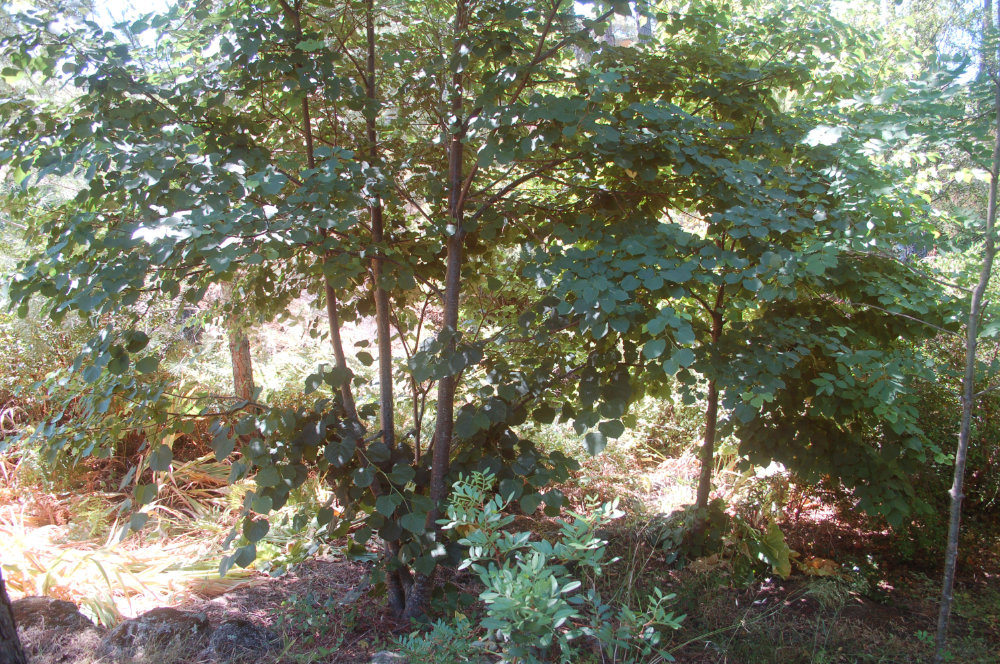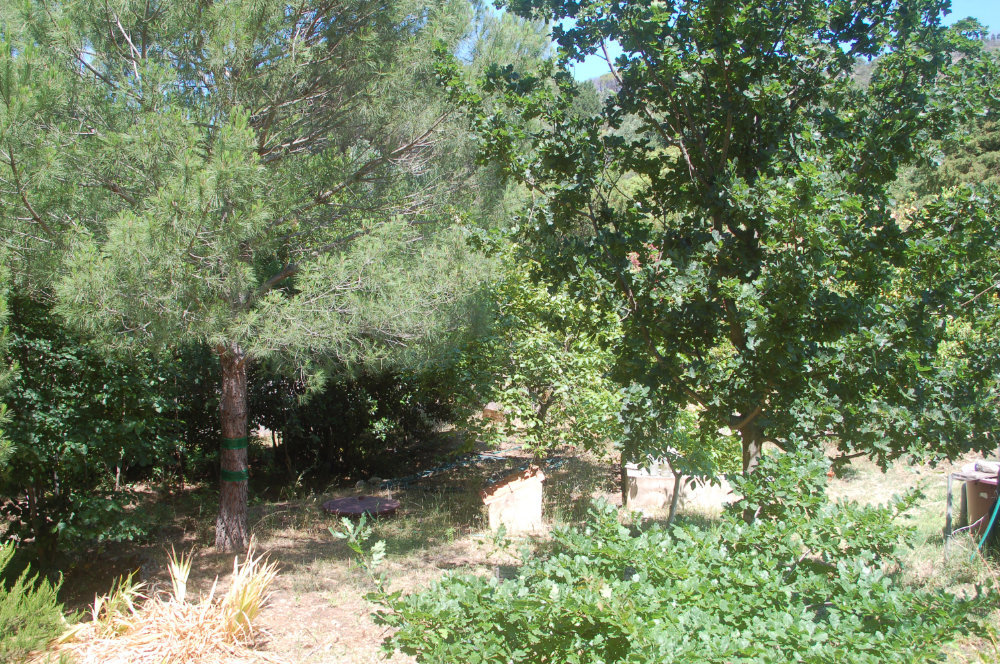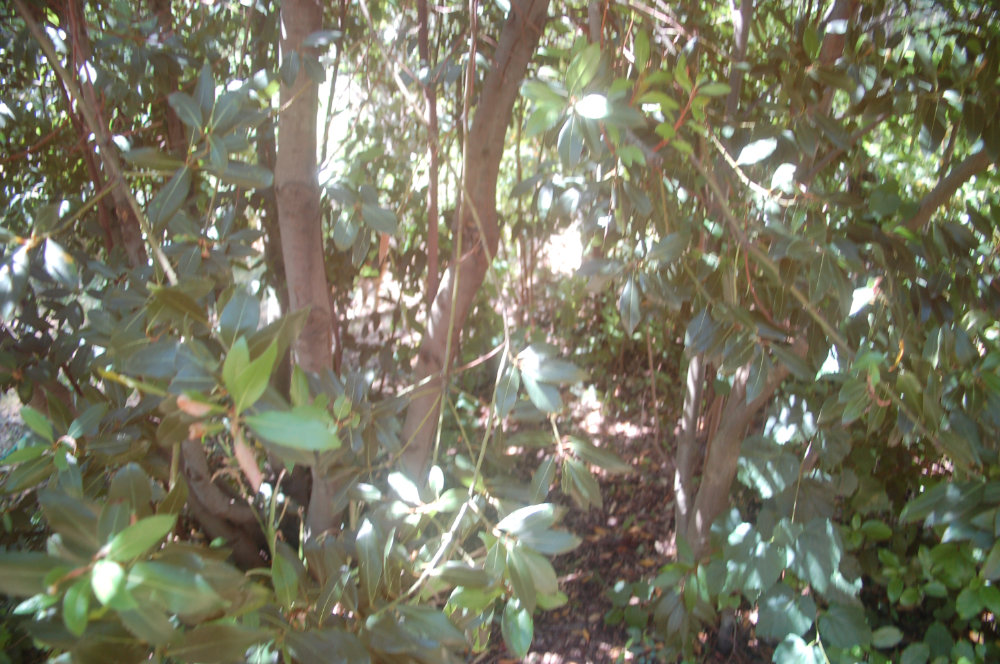Saturday the 11th june 2022.
Eighteen years ago, when we planted saplings in various beds and across different mountainous terraces of our plot of land, we weren’t yet familiar with the concept of the Miyawaki Forest, named after the Japanese botanist and plant ecologist Professor Akira Miyawaki (1928-2021, https://de.wikipedia.org/wiki/Akira_Miyawaki).
In 2004, when we received a donation of 5,000 different species of trees after the forest fire here in Monchique (11 September 2003) we were looking for a temporary space to keep these 15-cm saplings. I’m talking about oaks, alder, ash, linden, beech and carob trees, as well as umbrella pines and other species of trees, including the black walnut.
So this was the situation on our plot of land in Esgravatadouro. We laid down a PVC tarpaulin into the dug-out furrows and placed the saplings in there, using soil to cover the roots well. The PVC tarp was meant to keep the roots from digging themselves too deep into the soil within a few weeks, as the idea was to park these trees there only for a short period of time. Subsequently, we planted the first 1,000 trees in Monchique below the Picota summit. For this purpose we offered the Dalai Lama Foundation in Monchique the opportunity to reforest the 65 hectares of woodlands destroyed during the 2003 forest fire. Many other private landowners received trees from this donation, trees that we simply passed on. In the end we had planted over 4,800 trees. However, the roots of a few of the saplings had found a way round the PVC tarp and already taken root deeper in the soil. You could no longer take them out without destroying the roots and with that the tree itself. So we allowed those 200-or-so little trees to get on with growing and forgot about them over time…
… a Miyawaki Forest is occupying under 200 m² of our Esgravatadouro plot, with no artificial irrigation whatsoever. At the time we planted the saplings close to each other, allowing a space of between 20 and 30 cm between the trees. After all, the seedlings weren’t meant to remain there for very long, only a few months. Now however, 18 years later, we have taken out the odd tree, yet a very small surface houses a high number of many different species of trees. A forest has emerged, a place where it’s dark and always cooler than outside. I remember planting a bay leaf tree as one of the first ones, right in the centre, with an ancient olive tree standing at the edge of the plot. The bay leaf tree has thrived and is now the strongest of all the trees, the Mother Tree sharing its sweet nourishment with all the others.
We discovered the Miyawaki Method rather by chance browsing the specialised literature we usually consult when we have a question related to botany. In reestablishing and protecting natural forest eco systems, following forest fires in particular, Akira Miyawaki saw a deeper sense in life, a key for conserving Earth’s natural balance. One of the ideas he developed over the course of his research was this forestation method which is now known worldwide as the “Miyawaki Method”: creating the highest-possible biodiversity in a small space.
The Tiny Forests…
Large cities such as New Delhi, Tokyo or Nagasaki have very little space for large-scale forests. Even so, these cities too have Miyawaki Parks, just as in Esgravatadouro near Caldas de Monchique. Many small mini forests retain the humidity, and when 2018 came along, our Miyawaki Forest did not burn, having stored so much humidity in the soil and trunks that the fire came to a halt once it reached that small woodland. What you have to remember is that as a matter of principle we don’t plan any invasive species of trees such as eucalyptus or acacia that love fire and during a forest fire will spread their seeds to the tune of millions, defying any effort at balance. We plant woodlands because we enjoy doing exactly that.
Over a time period of not even 20 years a forest has emerged here, of the kind that planted the conventional way would need two to three generations to regenerate. In contrast to monocultures the high level of diversity of native plants offers a diverse habitat for flora & fauna. Tiny Forests act as cooling agents, ensure a favouable microclimate and protect from extreme heat. Through their dense multi-layered vegetation, but also through their roots and by supporting the upper soil level, Tiny Forests are twice as fast at storing twice CO2 compared to surfaces reforested the traditional way. Trees filter particles such as nitrogen oxides and sulfur oxides from the air and remove particulates from it. Just like a sponge, the forest islands absorb water and store it, acting as retainer surfaces during heavy rains.
Just like Terra Preta, the soil in Miyawaki Forest is a nutrient-rich substrate consisting of microbiologically-activated vegetable charcoal, ground clay and stone as well as compost. Where we live, the compost heap is standing right nearby. This soil serves to increase its capacity for storing nutrients and water as well as for the accumulation of humus. ECO123 offers training sessions and workshops so you may plant your own small forest following the Miyawaki philosophy!
For more information contact: editor@eco123.info
 Eco123 Revista da Economia e Ecologia
Eco123 Revista da Economia e Ecologia






